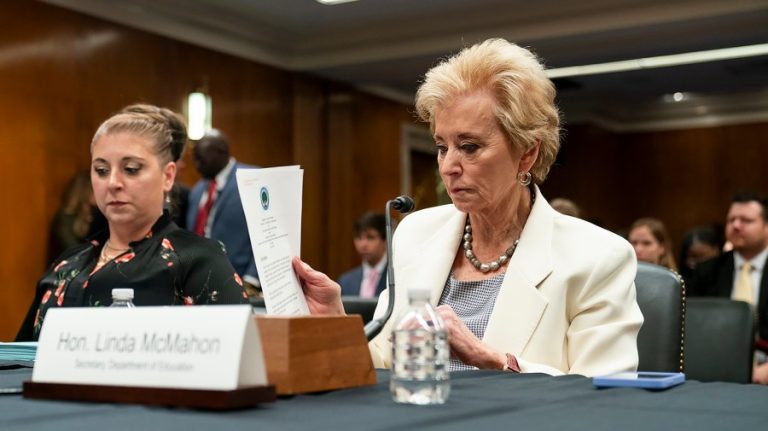The Education Department is trying to use the government shutdown to further push for its own elimination.
From an effort to layoff almost 500 more employees to messaging from Secretary Linda McMahon herself, the federal department, which President Trump has long sought to shutter, is seeking ways to make changes during the shutdown more permanent, alarming its defenders.
“It’s nonsensical to think that the Trump administration … has an interest in preserving the Department of Education and preserving civil rights enforcement at the federal level,” said David Hinojosa, co-director of litigation at the National Center for Youth Law.
Trump, who has told McMahon he wants her to put herself out of a job, had previously signed an executive order to shrink the agency and laid off half its workforce.
But the shutdown, which has lasted for more than three weeks with no end in sight, seems to be another window McMahon thinks she can use to further these efforts.
“The Democrat government shutdown has forced agencies to evaluate what federal responsibilities are truly critical for the American people. Two weeks in, millions of American students are still going to school, teachers are getting paid, and schools are operating as normal. It confirms what the President has said: the federal Department of Education is unnecessary, and we should return education to the states,” McMahon said in a statement on X.
“The Department has taken additional steps to better reach American students and families and root out the education bureaucracy that has burdened states and educators with unnecessary oversight,” she added.
Some 95 percent of department workers have been furloughed, pausing civil rights investigations and cutting funding for some schools, such as those that rely on Impact Aid.
But it will take time for further consequences to be obvious to the education sector, as most of the federal funding was already distributed to K-12 schools for the year. Federal dollars make up about 10 percent of the average district’s budget.
Opponents say it is a slight of hand to say a government shutdown is similar to if the agency didn’t exist all together.
“I think that is very disingenuous,” said Jon Valant, director of the Brown Center on Education Policy at the Brookings Institute. “What it shows is that the federal government is not running and has not ever run schools directly. We heard a lot of rhetoric at the beginning of this administration about how they were going to return control of education to the states, and that the federal government was kind of running everything in schools, and that was just never the case.”
“Now, what does happen when the federal government steps aside is we see fewer civil rights protections for students. We see that funds can be harder to obtain. We see fewer guardrails to ensure that funds are being spent as they should and that students are being served as they as they should we get less data and research and evidence on how American students are performing,” he added.
After the shutdown began, Trump attempted to institute mass layoffs across the government, including another 500 workers at the already gutted Education Department.
The layoffs, which were paused by the courts, had been expected to significantly shrink the offices that helps students with disabilities, civil rights investigations and those that distribute federal funds to schools.
McMahon has previously argued all these functions should either be moved to other federal agencies or the states. In her ideal world, civil rights investigations would go to the Department of Justice, oversight for the Individuals with Disabilities in Education Act would head to the Department of Health and Human Services and student loans would go to the Treasury Department.
Despite the outcry, the attempts to dwindle the number of employees could put states in a spot where they must start imagining their future without some federal services, whether they like it or not.
“I think states attorneys general and state commissioners of education should be in conversation about how to handle these civil rights complaints within their borders. I do think right that states should be looking for ways to use their own authority to help to resolve some of these things,” said Jonathan Butcher, the Will Skillman senior research fellow in education policy at the Heritage Foundation.
And if programs ever do get moved to other federal agencies, Butcher argues state education commissions and school districts will just have to adjust.
“Can we reconfigure the lines of communication between the Department of Justice, states attorneys general and state departments of education? Frankly, I don’t think it’s a stretch … This is not a foreign concept. It’s just a different part of the executive branch that the that schools and districts will need to be talking to, or state departments of education will need to be talking to,” he said.

